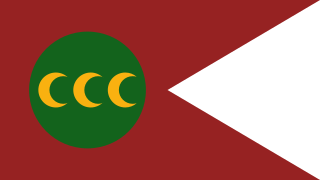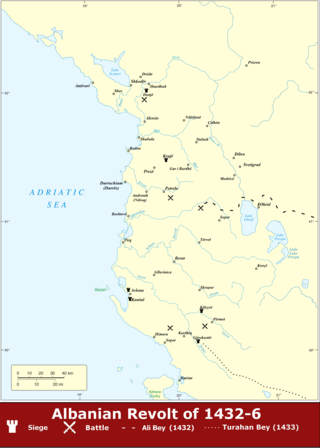
Sipahi were professional cavalrymen deployed by the Seljuks, and later by the Ottoman Empire. Sipahi units included the land grant-holding (timar) provincial timarli sipahi, which constituted most of the army, and the salaried regular kapikulu sipahi, or palace troops. However, the irregular light cavalry akıncı ("raiders") were not considered to be sipahi. The sipahi formed their own distinctive social classes and were rivals to the janissaries, the elite infantry corps of the sultans.
Ottoman Albania refers to a period in Albanian history from the Ottoman conquest in the late 15th century to the Albanian declaration of Independence and official secession from the Ottoman Empire in 1912. The Ottomans first entered Albania in 1385 upon the invitation of the Albanian noble Karl Thopia to suppress the forces of the noble Balša II during the battle of Savra. They had some previous influence in some Albanian regions after the battle of Savra in 1385 but not direct control. The Ottomans placed garrisons throughout southern Albania by 1420s and established formal jurisdiction in central Albania by 1431. Even though The Ottomans claimed rule of all Albanian lands, most Albanian ethnic territories were still governed by medieval Albanian nobility who were free of Ottoman rule. The Sanjak of Albania was established in 1420 or 1430 controlling mostly central Albania, while Ottoman rule became more consolidated in 1481, after the fall of Shkodra and League of Lezhe with the country being mostly free in the period of 1443–1481. Albanians revolted again in 1481 but the Ottomans finally controlled Albania by 1488.

The pronoia was a system of granting dedicated streams of state income to individuals and institutions in the late Byzantine Empire. Beginning in the 11th century and continuing until the empire's conquest in the 15th century, the system differed in significant ways from European feudalism of the same period.

The administrative divisions of the Ottoman Empire were administrative divisions of the state organisation of the Ottoman Empire. Outside this system were various types of vassal and tributary states.

Timariot was the name given to a Sipahi cavalryman in the Ottoman army. In return for service, each timariot received a parcel of revenue called a timar, a fief, which were usually recently conquered plots of agricultural land in the countryside. Far less commonly, the sultan would grant a civil servant or member of the imperial family a timar. Also non-military timar holders were obliged to supply the imperial army with soldiers and provisions.
Sanjak-bey, sanjaq-bey or -beg was the title given in the Ottoman Empire to a bey appointed to the military and administrative command of a district, hence the equivalent Arabic title of amir liwa He was answerable to a superior wāli or another provincial governor. In a few cases the sanjak-bey was himself directly answerable to Istanbul.

The history of the Ottoman Empire in the 18th century has classically been described as one of stagnation and reform. In analogy with 18th-century France, it is also known as the Ancien Régime or Old Regime, contrasting with the "New Regime" of the Nizam-i Cedid and Tanzimat in the 19th century.

Beylerbey was a high rank in the western Islamic world in the late Middle Ages and early modern period, from the Anatolian Seljuks and the Ilkhanids to Safavid Empire and the Ottoman Empire. Initially designating a commander-in-chief, it eventually came to be held by senior provincial governors. In Ottoman usage, where the rank survived the longest, it designated the governors-general of some of the largest and most important provinces, although in later centuries it became devalued into a mere honorific title. The title is originally Turkic and its equivalents in Arabic were amir al-umara, and in Persian, mir-i miran.
Under the Ottoman Empire, Mukata’a were hass-ı hümayun, parcels of land owned by the Ottoman crown. These were distributed through the iltizam auction system; rights to collect revenue from the land were sold to the highest bidder, eventually for the life of the buyer. As the Ottoman Empire began to move into the early modern period, vacant timars, instead of being reassigned, were often added to the iltizam system, paving the way for a fundamental change in the Ottoman fiscal system into a monetized system, and allowing various power-brokers to involve themselves in the Ottoman bureaucracy, which had previously been limited to the kul.
A timar was a land grant by the sultans of the Ottoman Empire between the fourteenth and sixteenth centuries, with an annual tax revenue of less than 20,000 akçes. The revenues produced from the land acted as compensation for military service. A holder of a timar was known as a timariot. If the revenues produced from the timar were from 20,000 to 100,000 akçes, the land grant was called a zeamet, and if they were above 100,000 akçes, the grant would be called a hass.

Chiflik, or chiftlik, is a Turkish term for a system of land management in the Ottoman Empire. Before the chiflik system the Empire used a non-hereditary form of land management called the timar system. As the Empire began to collapse, powerful military officers started to claim land from the sultan's holding allowing them to pass the land onto their sons, thus creating the chiflik system. This form of land management lasted from the 16th century until the collapse of the Ottoman Empire in 1919.
Strateia is a term used in the Byzantine Empire, which according to the Oxford Dictionary of Byzantium "signified enrollment into state or ecclesiastical service and the attendant obligations".

The Eyalet of Diyarbekir was an eyalet of the Ottoman Empire. Its reported area in the 19th century was 20,332 square miles (52,660 km2), slightly larger than the original Abbasid province in Upper Mesopotamia. In 1846 it was succeeded by the Kurdistan Eyalet.
A kadi was an official in the Ottoman Empire. The term kadi refers to judges who preside over matters in accordance with Islamic law, but in the Ottoman Empire, the kadi also became a crucial part of the central authority's administrative hierarchy. After Mehmed II codified his qanun, kadis relied on this dynastic secular law, local customs, and the sharia- Islamic divine law- to guide their rulings. Along with adjudicating over criminal and civil matters, the kadi oversaw the administration of religious endowments and was the legal guardian of orphans and others without a guardian. Although Muslims, in particular Muslim men, possessed a higher status in the kadi’s court, non-Muslims and foreigners also had access to the judicial system. Within the Ottoman's provincial administrative system, known as the timar system, the kadi served as an important check on the power of the military class. Despite the unquestioned authority of the sultan, kadis possessed a certain degree of autonomy in their rulings.
Taxation in the Ottoman Empire changed drastically over time, and was a complex patchwork of different taxes, exemptions, and local customs.
The tapu resmi was a feudal land tax in the Ottoman Empire.

The Albanian revolt of 1432–1436 was a series of conflicts between Albanian rebels and the Ottoman Empire during the early period of Ottoman rule in the region. Prompted by the replacement of large parts of the local nobility with Ottoman landowners, centralized governance, and the Ottoman taxation system, the population and the nobles, led principally by Gjergj Arianiti, revolted against the Ottomans.
The çift-hane system was the basic unit of agrarian land holding and taxation in the Ottoman Empire from its beginning. The pre-modern Ottoman system of land tenure was based on the distribution of land between publicly owned lands, miri and privately owned lands mülk, and the majority of the arable land was miri, especially grain-producing land. Peasants were the vast majority of the empire, and they worked as farmers on land designated as miri, relying heavily on wheat-barley production for their subsistence. The peasant household had been the basic form of agrarian production in much of the land ruled by the Ottomans since Roman times, and this had continued through Byzantine rule. So, the çift-hane system was based on the realities which were present in much of the lands the Ottomans conquered: a class of free peasants cultivating their own land, and a taxation policy combining Byzantine, Ottoman, and Islamic rules.

The Imperial Council or Imperial Divan, was the de facto cabinet of the Ottoman Empire for most of its history. Initially an informal gathering of the senior ministers presided over by the Sultan in person, in the mid-15th century the Council's composition and function became firmly regulated. The Grand vizier, who became the Sultan's deputy as the head of government, assumed the role of chairing the Council, which comprised also the other viziers, charged with military and political affairs, the two kadi'askers or military judges, the defterdars in charge of finances, the nişancı in charge of the palace scribal service, and later the Kapudan Pasha, the head of the Ottoman Navy, and occasionally the beylerbey of Rumelia and the Agha of the Janissaries. The Council met in a dedicated building in the Second Courtyard of the Topkapi Palace, initially daily, then for four days a week by the 16th century. Its remit encompassed all matters of governance of the Empire, although the exact proceedings are no longer known. It was assisted by an extensive secretarial bureaucracy under the reis ül-küttab for the drafting of appropriate documents and the keeping of records. The Imperial Council remained the main executive organ of the Ottoman state until the mid-17th century, after which it lost most of its power to the office of the Grand Vizier. With the Tanzimat reforms of the early 19th century, it was eventually succeeded by a Western-style cabinet government.
The Ayan was the class of local notables or dynasts in the 16th to the early 19th century Ottoman Empire who held varying degrees of authority in provincial towns and districts. The ayan had significant autonomy, and even armed force, but did not challenge the central Ottoman government. Though the title was awarded only to Muslims, its function was secular. The ayan included "wealthy merchants, heads of Janissary garrisons, leaders of important craft guilds, those who had bought the right to collect taxes for the government in Istanbul, and those who supervised the distributions of wealth generated by, and the maintenance of, pious endowments." The rise of the ayan class was part of the decentralizing trend in the Ottoman Empire which began in the 16th century, and came to define the Empire's structure until its fall in the early 20th century.